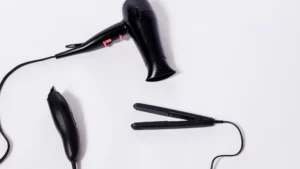Are you considering hair transplant surgery to address hair loss concerns? If so, you’ve likely come across the term “FUE hair transplant.” But what exactly is FUE, and how does it differ from other hair transplant techniques like FUT?
I’m Emma Wright, your hair restoration content specialist. As a hair restoration content specialist with over a decade of experience, I’ve witnessed the transformative impact of FUE on individuals’ confidence and self-esteem.
If you’re considering FUE hair transplant surgery, it’s essential to understand FUE hair transplant techniques and the differences between FUE hair transplant vs FUT. In this article, we’ll be looking at FUE hair transplant and explaining all you need to know about this hair loss treatment procedure.
FUE, or Follicular Unit Extraction, is a modern hair transplant technique that has gained popularity for its minimally invasive approach and natural-looking results.
Unlike traditional methods such as FUT (Follicular Unit Transplantation), which involves removing a strip of scalp tissue, FUE procedures extract individual hair follicles directly from the donor area using a specialized punch tool.
Let’s delve into the details of FUE hair transplant, including how it works, its benefits, risks, and costs.
What is FUE Hair Transplant?
Follicular Unit Extraction (FUE) hair transplant is an advanced surgical technique used to treat hair loss and restore natural hair growth. Unlike traditional methods such as Follicular Unit Transplantation (FUT), which involves removing a strip of scalp from the donor area, FUE involves extracting individual follicular units directly from the scalp using a specialized punch tool.
During the FUE procedure, the surgeon makes small circular incisions around each follicular unit, typically from the back or sides of the scalp, where hair is genetically resistant to balding. These follicular units are then carefully harvested and transplanted into the recipient area of the scalp, where hair loss has occurred.

FUE offers several advantages over traditional hair transplant techniques:
- Minimally Invasive: FUE involves smaller incisions and does not require the removal of a strip of scalp tissue, resulting in less scarring and a quicker recovery time.
- Natural-looking Results: By transplanting individual follicular units, FUE allows for precise placement of hair grafts, creating a natural hairline and appearance.
- Versatility: FUE can be used to transplant hair to various areas of the body, not just the scalp, making it suitable for eyebrow, beard, and body hair transplants.
How FUE Hair Transplant Works
Follicular Unit Extraction (FUE) hair transplant works by harvesting individual follicular units directly from the donor area of the scalp and transplanting them into the recipient area where hair loss has occurred.
Here’s a step-by-step breakdown of how the FUE procedure works:
- Donor Area Preparation: The donor area, typically located at the back or sides of the scalp, is trimmed short to facilitate easier extraction of follicular units.
- Local Anaesthesia: Local anesthesia is administered to numb both the donor and recipient areas, ensuring the patient’s comfort during the procedure.
- Extraction of Follicular Units: Using a specialized punch tool with a diameter ranging from 0.6mm to 1.0mm, the surgeon makes tiny circular incisions around each follicular unit in the donor area. These incisions are carefully made to avoid damaging surrounding hair follicles.
- Harvesting of Follicular Units: Once the incisions are made, the surgeon gently extracts individual follicular units from the scalp using forceps or a suction device. Each follicular unit typically contains one to four hairs.
- Recipient Site Creation: Meanwhile, the recipient area of the scalp, where hair transplantation will occur, is prepared by making small incisions or slits using a needle or blade. These incisions are made according to the natural angle and direction of the existing hair to ensure a natural-looking result.
- Transplantation of Follicular Units: The extracted follicular units are then meticulously transplanted into the recipient’s incisions, ensuring proper placement and alignment to achieve the desired density and hairline.
- Post-Procedure Care: After the transplantation is complete, the patient is provided with instructions for post-procedure care, including how to properly clean and care for the transplanted area to promote healing and optimal hair growth.
FUE Hair Transplant Costs
When considering the cost of a Follicular Unit Extraction (FUE) hair transplant, it’s worth noting that clinics in certain locations, such as the best hair transplant clinics in Turkey, may offer more competitive pricing compared to other places, particularly in Western countries like the United States or the United Kingdom.
In Turkey, FUE hair transplant procedures are often available at a fraction of the cost compared to clinics in Western countries. The lower cost is attributed to factors such as lower operating expenses, lower labor costs, and government incentives to promote medical tourism.
On average, the cost of an FUE hair transplant in Turkey ranges from $1,500 to $4,000, depending on the clinic, surgeon experience, and the number of grafts needed. This pricing is significantly lower compared to the average cost of $7,000 to $15,000 for the same procedure in Western countries.
While the lower cost of FUE hair transplant in Turkey may be appealing to many patients, it’s essential to research and carefully consider factors beyond just the price. When choosing a clinic, it’s crucial to prioritize factors such as the reputation of the clinic and surgeon, the quality of care and facilities, and patient reviews and testimonials.
Some patients may choose to travel to Turkey for their FUE hair transplant due to the cost savings, while others may prefer to undergo the procedure closer to home for convenience and peace of mind. Ultimately, the decision should be based on individual preferences, needs, and budget constraints.
Regardless of the location, patients should prioritize finding a qualified and experienced surgeon and a reputable clinic to ensure a safe and successful FUE hair transplant procedure. Investing time in thorough research and consultation with potential clinics can help patients make informed decisions and achieve optimal results.
If you’re interested in learning more about the best hair transplant clinics in Turkey, we invite you to explore our comprehensive clinic review for further guidance.
FUE Hair Transplant Benefits
Follicular Unit Extraction (FUE) hair transplant offers numerous benefits for individuals seeking to address hair loss and restore natural hair growth.
Here are some of the key advantages of FUE hair transplant:
- Natural-Looking Results: FUE hair transplant results in natural-looking hair growth that closely resembles the patient’s original hairline and density. The precise extraction and transplantation of individual follicular units allow for seamless integration with existing hair.
- Minimally Invasive Procedure: FUE is a minimally invasive surgical technique that involves making small, circular incisions to extract follicular units from the donor area. This approach results in less trauma to the scalp, reduced scarring, and a quicker recovery time compared to traditional methods like Follicular Unit Transplantation (FUT).
- Minimal Scarring: FUE hair transplant leaves minimal scarring in the donor area, as only tiny puncture wounds are made during the extraction process. This makes it ideal for patients who prefer to wear their hair short or who are concerned about visible scars.
- Versatility: FUE can be used to transplant hair to various areas of the body, not just the scalp. It is commonly used for eyebrow transplants, beard transplants, and even to restore hair in areas affected by scarring or trauma.
- Reduced Discomfort: FUE hair transplant typically involves less discomfort and post-operative pain compared to traditional methods. Patients often experience minimal swelling, bruising, and numbness, allowing for a more comfortable recovery process.
- Faster Recovery: The minimally invasive nature of FUE results in a faster recovery time compared to procedures like FUT, which requires the removal of a strip of scalp tissue. Most patients can resume their normal activities within a few days to a week after the procedure.
- Suitable for Tight Scalps: FUE is an excellent option for patients with tight scalps or limited donor hair availability. The ability to extract individual follicular units allows for the efficient use of available donor hair without compromising scalp elasticity.
- Long-Term Solution: FUE hair transplant provides a long-term solution for hair loss, with transplanted hair typically remaining permanent and resistant to further hair loss. This allows patients to enjoy lasting results and improved confidence in their appearance.
FUE Hair Transplant Risks
While FUE is generally considered safe, like any surgical procedure, it carries some risks, including:
- Infection
- Bleeding
- Swelling
- Temporary numbness or tingling
- Follicle damage or transection
FUE Hair Transplant vs. FUT
When considering hair transplant options, two primary techniques stand out: Follicular Unit Extraction (FUE) and Follicular Unit Transplantation (FUT).
Let’s compare these two methods:
-
Extraction Technique
- FUE: Involves the extraction of individual follicular units directly from the donor area using a specialized punch tool. This results in small, circular incisions with minimal scarring.
- FUT: Involves the removal of a strip of scalp tissue from the donor area, which is then dissected into individual follicular units for transplantation. This technique leaves a linear scar along the donor area.
-
Scarring
- FUE: Leaves tiny, dot-like scars scattered across the donor area, which are less noticeable and easier to conceal, making it suitable for patients who prefer to wear their hair short.
- FUT: Leaves a linear scar along the donor area, which may be more noticeable, especially for patients with short hairstyles.
-
Recovery Time
- FUE: Typically involves a quicker recovery time compared to FUT, as there are no stitches or sutures required, and patients experience less post-operative discomfort.
- FUT: May require a longer recovery time due to the need for suture removal and potential discomfort associated with the linear scar.
-
Donor Area Utilization
- FUE: Allows for the selective extraction of individual follicular units, making it suitable for patients with limited donor hair availability or tight scalps.
- FUT: Utilizes a larger portion of the donor area, potentially yielding a higher number of grafts in a single session. However, it may not be suitable for patients with limited scalp laxity.
-
Natural-Looking Results:
- Both FUE and FUT can achieve natural-looking results when performed by a skilled and experienced surgeon. The key is in the meticulous placement and alignment of the transplanted follicular units to create a seamless hairline and density.
-
Cost
- FUE: Generally, FUE hair transplants tend to be more expensive than FUT due to the time-consuming nature of the procedure and the specialized equipment required.
- FUT: Typically, FUT is less expensive than FUE, as it involves a simpler extraction process and may require fewer surgical team members.
Now You Know!
FUE hair transplant offers a modern, minimally invasive solution for addressing hair loss and achieving natural-looking results. While it comes with several benefits, it’s essential to weigh the risks and costs before undergoing the procedure. Consulting with a qualified hair transplant surgeon can help you determine if FUE is the right option for you.
For personalized advice and recommendations on FUE hair transplant clinics, feel free to explore our hair transplant clinic reviews. Don’t let hair loss hold you back from feeling confident and comfortable in your appearance.
Reach out to us today to take the first step toward hair restoration.














